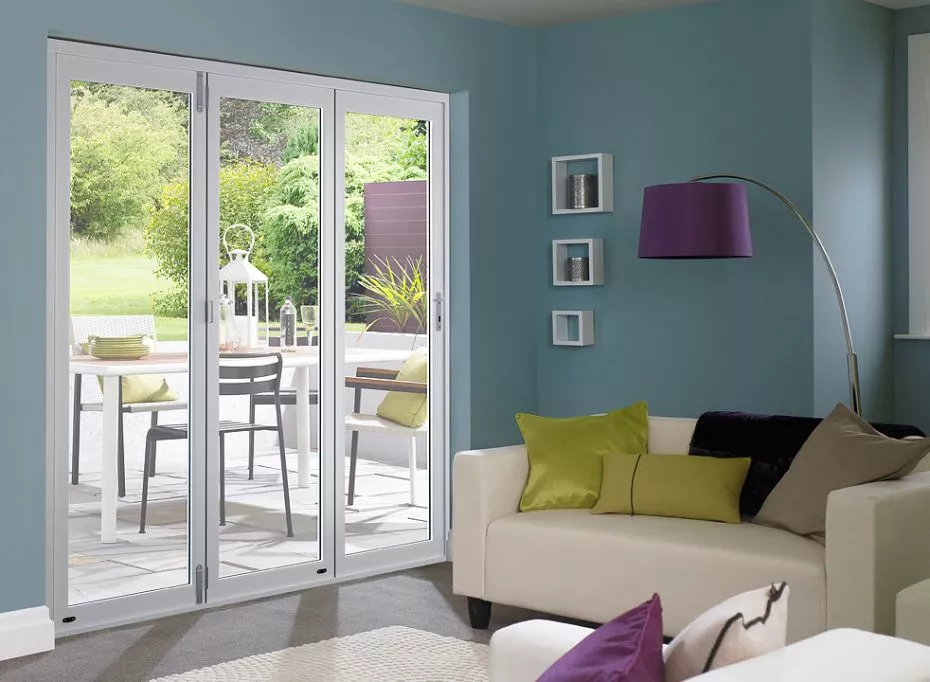When you’re looking for ways to make your home lighter and your space appear larger, one of the best home improvement ideas is to fit external patio doors that incorporate glass panels. Both bifold doors and sliding doors fall into this category, flooding your home with natural light.
So, how do you choose between these two popular options? This guide compares bifold and sliding doors, taking into account the pros and cons of each.
In this guide:
Going back to the basics, explaining the key features of a bifold door and how they operate.
This section will detail some of the key advantages of bifold doors.
This section details some of the reasons an external bifold door set may not be right for you.
This section details the main aspects of a sliding door.
Like bifolds, sliding doors offer many great benefits. Find out more in this section.
Like anything, sliding doors can come with some downsides. Find out more here.
A final comparison to help you decide which type of door would be the most suitable for your home.
We answer common queries on sliding doors vs bifold doors.
What is a bifold door?
A ‘bifold’ refers to a door that has a concertina effect when opened. It folds in on itself to allow you to walk through the doorway. Internal bifold doors are often used as room dividers, as the doors can be easily opened to create one open plan living space.
External bifolds are built to look stunning while also providing important energy efficient values. Read our complete guide to the benefits of bifold doors here.
How do bifold doors work?
Bifolds come in a range of sizes and materials. They operate along a track system that ensures they can be effortlessly opened and closed.
The doors (or leaves) are fitted to runners that run along a track system. As the doors run along the track, they fold at the same time to create a seamless operation. The doors stack at either end of the door, creating a wide opening.
All bifold doors require a main track and guide track to operate. You can find variations of track systems, such as top-hung and bottom-rolling:
You can find out more about the advantages and disadvantages of each type of track system by visiting our external bifold door FAQs.
Shop our full range of external bifold doors here.
What are the advantages of bifold doors?
There are dozens of advantages to installing exterior bifold doors on your property:
Enjoy amazing views
Installing bifold doors means you get to showcase your beautiful garden or other features. Installing a bifold with thinner thresholds means more glass and even better views! Aluminium bifolds offer some of the thinnest sightlines around and make an eye-catching addition your home.
Increased natural light
With more glass comes more natural light. You can illuminate a dark kitchen or other interiors with a new bifold door. Combining a bifold door with a matching window means even more light while keeping the style consistent. Read more about the benefits of bifold doors for brightening up your home office here.
Fantastic flexibility
Bifold doors offer a level of flexibility in usage that few other doors can match. You have the option of opening the entire door for maximum impact or simply using the traffic door for normal usage. A traffic door is a panel (or leaf) that can be open and closed like a regular door. If you plan on using your bifold door often, you should consider a traffic door.
Variety of materials
Bifold doors can come in a variety of materials such as:
Read our guide to choosing a bifold door material here.
ARE YOU LOOKING FOR A BLACK ALUMINIUM DOOR WITH EXCELLENT THERMAL EFFICIENCY?
Our pick:
Heritage Supreme aluminium bifold doors
From £2,009.

The Heritage Supreme aluminium range is manufactured in the UK in our purpose-built factory; it’s designed with narrow sightlines but still offers durability and high security.
With a range of options to configure the doors to your needs and taste. Our Heritage ‘steel look’ bifold doors really can help you complete that Industrial look that is so on trend at the moment.
Shop our Heritage Supreme bifold doors.
What are the disadvantages of external bifold doors?
Bifold doors offer many benefits. However, there are also some potential downsides of bifold doors:
-
May need to stack inside the home. Most external doors can be stacked outside the home, meaning you don’t lose any space. However, if the outside space doesn’t have much room (like a small balcony etc.) you may need to ensure there is space inside the home so the doors can open inwards.
-
Can be more expensive than standard doors. With the amount of engineering required and the quality of the doors, it should be unsurprising to find that bifold doors can be more expensive than standard patio doors. However, this is not always the case, and you should take your time in researching the best prices.
Find out more about the costs of bifold and sliding doors in our expert guide.
What is a sliding door?
Like external and internal bifold doors, sliding doors move horizontally along a track. However, unlike bifold, the moving door panel simply sits over a static panel.
Sliding doors often utilise larger leaves (panes of glass) which offer wide, uninterrupted views. The stacked system saves space. However, the doors cannot be ‘fully opened’ as one leaf has to be sitting on top of the other. This may compromise your view slightly when compared to bifold doors.
What are the benefits of sliding doors?
A sliding patio door offers many of the same benefits as a bifold door, such as:
Stunning views—with wide panes of glass, sliding patio doors offer uninterrupted views.
-
Natural light—their large glass panels ensure a brighter room.
-
Easy operation—sliding doors simply move along a track and stack on top of each other.
-
Feeling of space—like bifolds, sliding doors have the ability to ‘bring the outside in’, meaning a flow between indoors and outdoors can be created.
-
Excellent security—again, like bifold doors, quality aluminium sliding doors will feature a type of security glass and utilise a multipoint locking system.
Potential disadvantages of sliding doors
Like anything, sliding doors come with some downsides:
-
Unlikely to open fully. Due to the operation of sliders, there must be a static glass panel that the operational pane sits on top of, meaning you cannot fully open the space. However, due to the large panes used in sliding doors, you will still get a wide opening and an excellent inside/outside flow.
-
Bottom-rolling. Because of the weight of the panes, sliding doors roll along the bottom sill. Generally, top-hung doors are considered superior due to easier operation and less maintenance. However, bottom-rolling is still a very viable option.
Bring in more natural light with the Supreme sliding door range
Our modern Supreme aluminium sliding doors are popular choice for many homeowners due to their sleek appearance, durability, and energy efficiency. They are made with high-quality, low maintenance aluminium frames.
These eye-catching modern external sliding doors are supplied with low-emissivity (low-E) glass, and thermal breaks to further improve their energy efficiency. Offering U-Values of only 1.6 W/m2K, you are guaranteed exceptional thermal efficiency for your home with our Supreme aluminium sliding door range.
From £2199

Shop our Supreme aluminium sliding door range today.
Bifold doors vs sliding doors | A complete comparison
Choosing between a bifold door and sliding door does not come down to ‘which is better?’. Both doors offer a range of benefits and can suit almost any home. It all comes down to buying the best door to match your layout, lifestyle and preferences.
Bifold doors and sliding doors often get confused with each other but they are separate types of doors, often used as a patio door, that offer a very different experience and different benefits:
Operation
One of the main differences between sliding doors and bifold doors is the way they operate. Sliding doors are made up of large panes of glass that move sideways along a track, stacking at the end of their frame. Typically used as patio doors, they allow an uninterrupted view of the outside.
Bifold doors (also known as a folding door) are made up of several large panes of glass which fold back on themselves in concertina. Unlike sliding doors, this means they can open up fully – even opening up one entire wall to the outside. Many bifold doors also have a lead door or a traffic door which can be opened independently without having to fold the full set of doors back. This functionality is ideal for homeowners with pets or children.
Thermal efficiency
While many believe that having a large glass patio door will mean that your home is less thermally efficient, with modern bifold and sliding doors, this is not the case. High-quality, modern glazed doors such as bifolds or sliding doors will not mean that the temperature in the room they’re installed or throughout the rest of your home will fluctuate dramatically. Find out more about bifold door U-values here.
For homeowners looking to renovate a property and make it more energy efficient, bifolding doors can be a great option. With Vufold’s range of exterior bifold doors, all panels are double glazed with the option of triple glazing and have low U-values, meaning a reduction in heat transfer that keeps rooms cool in the summer and warm in the winter. Read our complete guide to bifold door thermal efficiency.

Differing price ranges
When purchasing both types of doors - the frame material and dimensions will have an impact on the cost. However, there is a difference in price range when it comes to the two types of doors.
While the cost of bifold doors from Vufold starts at £1,809, sliding door prices start at £2,199. So, depending on what your needs are, they can appeal to very different budgets. Read our guide to bifold vs sliding door costs here.
It’s also important to consider the delivery costs of glass sliding doors as they can be higher than bifold doors due to the weight of the door panels containing large expanses of glass. They can require specialist fitting and lifting equipment during delivery and installation, so this is also an important factor to consider when weighing up your options.
Read our bifold door vs sliding door costs guide for more information.
Finishes and materials
Vufold’s sliding doors are made with slim, robust aluminium frames with toughened glass panels. However, if you’re looking for a wider range of finishes, Vufold’s bifolding doors come in a range of colours and are available in both alumunium and wood. This makes them a versatile choice, as they can be specified to match the style of your home and existing décor.
Are you choosing a bifold door colour? Read our guide to oak vs white bifold doors.
Get in touch for more ideas and inspiration, to find your superbly engineered and attractive bifold or sliding door.
Frequently asked questions
What are the main differences between sliding doors and bifold doors?
The key difference between each door lies in their mechanisms. Sliding doors glide along a track, leaving one panel fixed while the other slides open. In contrast, bifold doors consist of multiple panels that fold and stack neatly to the side when opened. Sliding doors are ideal for uninterrupted views as they feature larger glass panels, while bifold doors offer a fully open aperture, perfect for creating a seamless indoor-outdoor connection.
Which is better for small spaces: sliding doors or bifold doors?
For small spaces, bifold doors often have the edge because they fold compactly, allowing maximum opening without requiring additional room for operation. Sliding doors, however, always have at least one fixed panel, meaning you won’t achieve a completely open space. Bifold doors can also be designed with traffic doors, offering quick access without folding all panels.
Which is more secure: sliding doors or bifold doors?
Both door styles can be very secure, provided they feature robust locking systems. Sliding doors often have multipoint locks and interlocking panels, making them resistant to forced entry. Bifold doors also offer high security when equipped with multipoint locking systems on each panel and shoot bolts to anchor them firmly in place. Always ensure your doors meet security standards such as PAS 24 for peace of mind.
RELATED CONTENT






